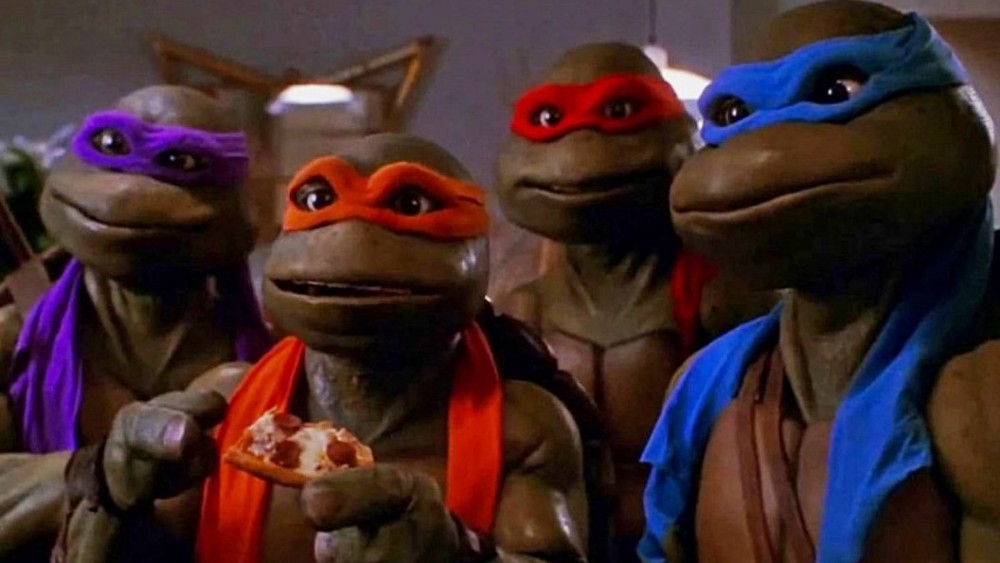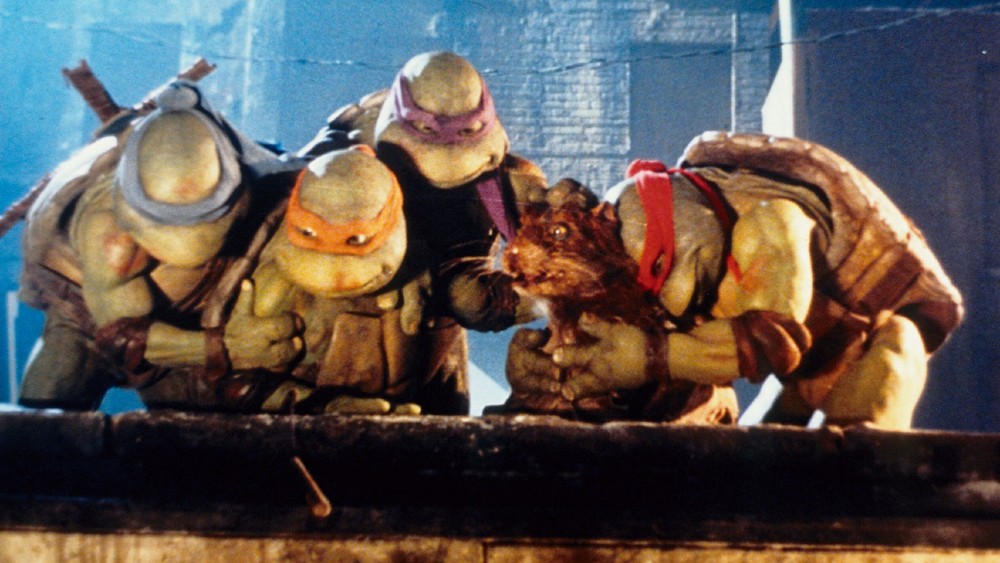
It’s been over 30 years since New Line Cinema released the original Teenage Mutant Ninja Turtles into theaters, where it became the highest-grossing independent film ever made at the time. Tonight, October 7, I will be hosting a special outdoor screening of Teenage Mutant Ninja Turtles in the city it’s set in, New York City, to celebrate the upcoming fall opening Alamo Drafthouse‘s new Lower Manhattan location. The screening will begin at 7 P.M. outside of 28 Liberty Street’s South Plaza, with popcorn and themed giveaways along with a costume contest before the show.
As it happens, my cousin Marta Evry was an apprentice editor for the late Sally Menke (Kill Bill, Pulp Fiction) on Teenage Mutant Ninja Turtles. Now a veteran editor on shows such as Lovecraft Country and The Man in the High Castle, Marta Evry took time out to discuss working on Ninja Turtles under Quentin Tarantino‘s eventual go-to cutter, how the director of the film got himself fired, and the footage she found that saved one particular scene.

Below the Line: How did you land your job as apprentice editor on Teenage Mutant Ninja Turtles, especially since this was your first big feature gig?
Marta Evry: Sally Menke was cutting this, way before she started working on the Tarantino movies. It must have been a New York connection that got me an interview, and Sally had just come out here to LA from New York. They were going to shoot in Wilmington, North Carolina, and so they wanted somebody who was willing to work as a local, and I had been there before. They were shooting in North Carolina in the middle of summer. At that time there was no CGI, it was all what they call creature effects, actors in costumes. They were wearing real rubber latex costumes. The animatronic heads were controlled by puppeteers.
BTL: I believe it was the Henson people.
Evry: It was the Henson’s doing it with radio signals. I don’t remember there being a lot of wirework we had to get rid of.
BTL: When you were getting the first rushes back, obviously it wasn’t Corey Feldman and all these people doing the voices. It was just whoever doing the voice and then probably a lot of servo sounds coming from the animatronics, right?
Evry: Sound was crap, completely unusable. It was like all of that, but they were yelling loud enough that you could hear and understand what they were saying. One of the puppeteers, Kevin Clash, who did Splinter, actually ended up voicing his own character. It was a lot of fun, but at the same time God I wouldn’t want to be one of those actors. I have a picture somewhere of when one of the actors came into the cutting room wanting to see some footage of what they had done. He was in the middle of shooting, so he showed up in full costume but without the head. He’s sitting at a Moviola watching dailies in full turtle costume, which is really, really funny.
BTL: How would you describe your job working for Sally? Were you getting footage as they were shooting or was it all post?
Evry: We were getting footage as they were shooting. Mind you, this was film, not digital. This is not working on an Avid. We were working on Moviolas and in KEMs. We would get the film and the single track, which is the sound, and as an apprentice it was my job to sync everything up. Then we would break everything down into Moviola rolls, which is single takes. That material would be given to Sally and she’d work with it, and then at the end of the day we’d have a huge bin full of what they called trims, which is all the bits and pieces she didn’t use. I would be responsible for getting all the trims and bits in what they call reconning. I would have to splice all these bits and pieces back together and keep everything in sync. If I had more picture than sound, then I’d end up splicing in white leader so that eventually it would go back into sync. This was so the next time the editor wanted to look at the dailies after they cut something they were able to do that. It was a lot of physical work. It was sort of like being a shoemaker on an assembly line, it felt a little like a factory job and not so creative.
BTL: How well organized was Sally?
Evry: Pretty well organized. There were three of us who were on location: Sally, her assistant Suzy Elmiger, who has gone on to cut, and then myself. The day would usually start with watching dailies in the afternoon, because that’s when they would be available. We’d actually go into a screening room, sometimes with the director but that wasn’t always possible. Once we had watched and she had taken notes, we would break everything down into Moviola rolls and KEM rolls that she could actually cut with. At the end of the day if she was done with the scene we would go through and recon everything. It had to be organized. All cutting rooms in the film days pretty much ran the same way. We were pretty efficient because we had to stay ahead of the editor. With electronic now it’s kind of the opposite, you just sort of scan everything and then you start feeling your way through a scene. You couldn’t do that in the film days because you didn’t want to slice and dice the film too much.

BTL: I just watched the film again today and reassessing the context it was made in, before people knew it was gonna be such a big hit. Prior to this there had been movies like Howard the Duck and Masters of the Universe, and neither of those worked. What was the vibe as the footage started rolling in? Were people like, “Oh, it’s another turkey,” or did they think Teenage Mutant Ninja Turtles could actually be something?
Evry: I had never heard of Teenage Mutant Ninja Turtles until six months before I started working on this thing. I had no clue who the characters were. The dailies were cute. The characters and the suits were really charming. It had a lot of good heart. Things like Howard the Duck were huge and there was something about it that just didn’t work. It either wasn’t absurd enough or it wasn’t charming enough. Teenage Mutant Ninja Turtles had a built-in audience who loved the comic books, but it was something that kids loved and that parents didn’t mind taking them to see.
BTL: It felt like it set the template for the prototypical Marvel movie, where they’re taking the mythology and the characters seriously by maintaining fidelity, but leaving room for levity and acknowledgment of the concept’s absurdity. They’re never talking down to it. It’s never a farce.
Evry: No. It wasn’t full of snark and irony. I was gonna say it took the movie seriously, but I think that’s the wrong word for it. It’s not a very serious movie, but I think a big difference was because Jim Henson’s people were involved. Henson did not direct this, but was very very involved in it. Both he and his son Brian, actually.
There was a certain gentleness to the whole thing. And also, it was just really cool going to the creature shop where they had multiple suits they were working on. They were always having to either repair or manufacture new heads and suits all the time because these things would just dissolve in the heat. If anybody has been to coastal North Carolina in the middle of summer… let’s just say it’s moist. Very moist. They brought a lot of creature people over from Henson’s shop in England, so there were a fair amount of Brits and that was really cool because I actually took a trip to England not too long after that and got to visit the creature shop where I saw all these works in progress. One thing I got to take away was a plaster life mask of Sean Connery, because they did some of the creature effects for Highlander, including when Sean Connery’s character gets his head chopped off. I still have that hanging in my house.

BTL: The director Steve Barron is also from the UK, I believe he’s Irish, right?
Evry: Yeah. Not a lot of people know this, but Steve Barron was actually fired off the movie. We had shot it, we got to Director’s Cut. At this point, they had hired two other editors, James Symons and William Gordean, to assist Sally because it was a lot of fight scenes and we were cutting on film. The director ended up screening the film for a group of investors not affiliated with Golden Harvest, who were the ones actually making the film. He wanted to do more with the film than Golden Harvest wanted to do. For some reason he thought it would be okay to do a secret screening for these other investors without Golden Harvest’s knowledge. Then Golden Harvest found out and fired him.
BTL: Was the intention to try to get these other investors to take over the project from Golden Harvest, so he could do it his way?
Evry: More or less. That’s what he was trying to do. I don’t know why he thought he could do that or get away with it. So they said, “Thank you very much. Your services are no longer needed.” Sally left the show with the director through solidarity. I stayed because I needed the work. I ended up working for the other two until the project was completed.
BTL: So who became the de facto director at that point?
Evry: Bill did, weirdly. They didn’t need to shoot anything else. It really was a matter of getting it into shape for screenings. We did a number of temp mixes for screenings. After the first focus group screening, I think we realized we had something that could probably do very well. Then it was just a matter of tweaking it. The movie was 90% there by the time Steve left, and then it was just getting that last 10% for clarity, humor, and to make sure the action was as exciting as possible.
BTL: What was the tug of war with Steve and the production company really over if it was so close to the end?
Evry: I’m not entirely clear on it. I think he wanted to do some more experimental stuff. There’s some like flashbacks in there…
BTL: The flashback sequences with Splinter remembering the origin of the turtles and the death of his master?
Evry: Yeah, I think he wanted to do something a little bit more experimental than what we did. But again, the material had already been shot. So it was stylized already.
BTL: Those scenes had a higher amount of grain than the rest of the film.
Evry: It was shot that way. They did it on purpose. I wasn’t privy to this, I don’t know why Steve wanted to do that either. Maybe it was something Golden Harvest wouldn’t let him do, or that he needed more money than they were willing to pay?

BTL: Was there anything memorable that got cut out of the film?
Evry: Not really. What you see is pretty much… There’s no secret turtle sex scene or anything.
BTL: The tough part of the business is all these jobs are temporary. When you’re below the line at a certain point along the pipeline, they just don’t need you anymore. How did you end on the film?
Evry: I was on it through the mix. There was always something that somebody needed. Picture editorial in those days, when you’re doing a mix, you spent a lot of time on standby. They didn’t let you go because you might have to dig something up. You’ve got to find a piece of single track or alternative readings for something, and there wasn’t a computer you can pull this up on. You had to pull the film and look for it. I was on through the mix, and then left after that.
BTL: When Teenage Mutant Ninja Turtles finally came out, how did you react to it? Did you see it with an audience?
Evry: I have never seen the film. I’m sure it’s lovely. When they did the cast and crew screening and the premieres I think I was working on something else, so I couldn’t see it.
BTL: But of course, you’ve probably seen it in some form or another 800 times.
Evry: Oh, yes. Definitely, in one form or another. The other thing that was kind of fun is… there was no real reason for me to be there, but I was just interested in ADR. You would have Corey Feldman come in and do the ADR. He’d do half-an-hour’s worth of work, and then he would disappear into the bathroom for 45 minutes, and then come back and start talking really fast, then slow down and have to go back to the bathroom. I don’t think I’m telling any tales out of school.
BTL: In terms of your experience as an editor, because you’ve gone on to have a long career, what did you kind of take away from working on this project?
Evry: There was actually one thing that I took away that has been really valuable. There was a scene in a tunnel where one of the bad guys is supposed to have been listening in on what the turtles are talking about in their lair, but nobody ever shot anything of one of the Foot soldiers in that costume down in the sewers. James, one of the additional editors, basically came to me and said, “Do we have any stuff that we haven’t used, like camera tests?” Because they couldn’t find a shot of that anywhere. We did have a lot of camera tests, so he threw all those up on the KEM and lo and behold, there was a shot. It was a camera test of the bad guy in costume, in one of the tunnels that had been fully lit, skulking around, just as a lighting test. And he used it. It’s in the finished film. That was really valuable to me, because it was like, “If you don’t have the shot, keep looking.” You never know where you might find something that is usable. It wasn’t something that was meant to be used in that moment, but it’s surprising what you can get away with.
If you happen to be in New York City tonight, writer Max Evry will be introducing an outdoor screening of Teenage Mutant Ninja Turtles tonight at the new Alamo Drafthouse Lower Manhattan at 28 Liberty Stree on the South Plaza.
All photos courtesy New Line Cinema, except where noted.





